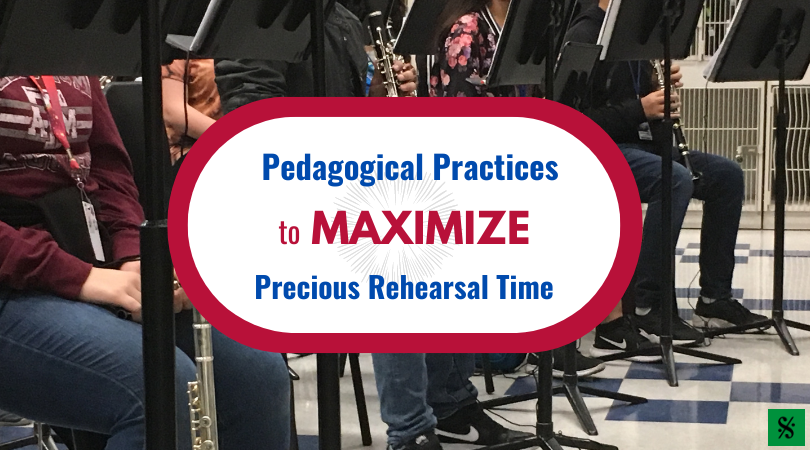
The most profound revelation for me as a musician came when I left the role of secondary music educator to embark on this journey to become a collegiate/professional conductor. This move immediately highlighted a host of differences in expectations of the performers, conductors and audience members alike. The level of expertise and pace at which the professional path conductor and players must work is staggering. Although we are interested in meeting the same core concepts as it relates to performance with ensembles at every level, the process of how these goals are achieved will vary greatly due to the proficiency level of the individual player and the ensemble’s conductor. In addition to this labyrinth of possible “wrong” turns, a warm-up concept, the literature, equipment and class environment will have a significant impact on how successfully the ensemble can prepare the music for performance.
This article will cover some best practices, which will provide evidence in support of a hierarchy of importance in rehearsal objectives. The main goal is to inform the music educator of which order the objective aspects (rhythms, notes, blend, tone quality, timbre, intonation, articulation, dynamics, balance, and shaping of line) of music-making should be prioritized to fastest reach a perception of quality by a higher number of listeners.
As a point of departure, we must have an agreed upon set of objective criteria for the conductor, performers, and audience members to analyze their experience. After years in construction as a certified contractor in Florida and years in the secondary music education setting, I could draw some similarities and transfers from two very different activities. I wanted to test a theory I had about the construction of residential and commercial spaces and test that process with the construction of a musical performance at the secondary level. There was always a logical flow of how each of the subcontractors was called to the job sight. It would make no sense to have the interior designer show up and hang curtains when the foundation has not yet had the opportunity to dry.
Transferrable to the previously explained situation, it would make no sense to have a discussion of phrasing and shaping of line when notes and rhythms are still a major concern. This approach does not appeal to the professional. The goal of the professional is to address all things at all times. This all-encompassing approach may prove to be more challenging for the secondary music education setting where all aspects of the music making process may not be second nature to the conductor or the performers. The process of chaining or scaffolding comes to mind as a model for how many educators across America have grown accustomed to teaching.
Your ability to move through these concepts with relative ease is a byproduct of the repertoire you have chosen for your ensemble. Many secondary music educators, even those with a significant amount of experience, will from time to time chose music that is inappropriate for the ensemble they have in front of them. Even if the ensemble and the conductor have been known for some time as performers of the most difficult literature, the group you may currently have is worth reevaluating every year. It is important to know how crucial that oboe player or horn section is to the level of literature you should expose your ensemble too. What your students are playing will ultimately determine the success with which you can instruct. If it is not a match for the skills they possess, the instructor could spend much of their time trying to recover from the gap that exists from available skills versus what the repertoire is demanding of the players.
Phase I – Notes and Rhythms
Rhythms and Notes are two objective criteria that make up our first building block. This all seems self-explanatory, but it is surprising how many performances could have many hidden (and not so hidden) wrong notes and rhythms that a director has just gotten accustomed to hearing in the construction process. This step requires that the director has very intimate knowledge of the score. They must also have the ability to predict what the pitfalls will be based on what they know about the ensemble’s skill level. This step is analogous to the foundation of the house and its importance to the integrity of the structure. The importance of this step cannot be emphasized enough.
Phase II – Blend, Tone, Timbre, and Intonation
Uncommonly interconnected are the concepts of blend, tone, timbre, and intonation. The perception of quality in this phase depends on how well the end goal is achieved. However, it is not advisable to pursue intonation in isolation. The understanding of how to create beautifully blended sounds have to be achieved before the good intonation could become a possibility. Blend is more closely associated with the volume of the same or similar parts being played by the same or different instruments. Having characteristic tone quality also helps to create an environment where good blend can be achieved. Playing on the best possible equipment will increase your students’ chances of playing with a beautiful tone on their instruments. The orchestration choices of the composer determine what instruments will be playing together at any given time. It is important to note that, to achieve good blend, timbre or the collection of instruments in the orchestration must be considered. The first three elements in Phase II combine to create the conditions for the final objective. They are prerequisites for great intonation. In short:
Tone + Timbre + Blend = Intonation
When considering intonation the ensemble and the director should think of it both vertically and horizontally. The horizontal aspect deals with a single line, unison or in octaves and equal temperament intervals between each note (similar to a piano). This could be more difficult to achieve when there are multiple instruments playing the same part with different pitch tendencies. Vertical tuning usually deals with a collection of pitches outlining some form of harmony. This can most easily be encountered when dealing with homophonic, or choral-style music – and even more easily with lyrical passages. Just intonation is necessary when successfully achieving vertical tuning. It is called vertical because it follows the harmonic rhythm of a given piece of music and it takes a vertical snapshot of the harmonic language occurring from one moment to the next. This requires slight pitch adjustments to be made from the root of a harmonically functional triad or chord. The overtone series is the principle on which just intonation is based and resources are readily available online that explain the notes in the chords relation to their equal temperament namesakes.
Phase III – Articulation and Precision
The next phase will add a level of polish and sophistication to your ensemble’s performance. Once all the other components from Phase I and II have been carefully constructed, this building block will help to highlight and add focus to the previous elements. Articulation acts as a prerequisite to precision. If there is no uniformity of note length, it will be very difficult to ensure all the musical moments are in alignment with one another. Clear articulation can be achieved if the ensemble is using the concepts presented in the blend section of Phase II. The same intensity of attack, tenuto, decay, etc. will instantly create the perception of uniformity, clarity and ensemble precision.
Phase IV- Phrasing/Shaping of Line and Balance
Careful study of harmony, motivic development, and the musical intuition of the conductor will reveal a stylistically acceptable interpretation of the phrase/shaping of line. In many situations with music that follows the harmonic practices of the 19th century and prior, the cadence acts as a checkpoint to the arc of the phrase/shape of line. This could also (but not always) affect the tempi which are selected due to a limited supply of air available to developing players. The slower the tempo, the more difficult it will be for the developing performers.
In homophonic music, the balancing of melodic material versus the accompaniment parts should be intentionally adjusted so the melodic music is clearly heard in the room as the dominant voice. The orchestration, the performance hall, and the strength of the players could pose additional challenges for this concept. Just as in visual art, music can reflect a foreground, middle ground and background. It is important that every musician in the room knows their role. This will create an intentional sense of balance between the separate parts.
The above-mentioned criteria can be approached systematically (in a scholastic setting with only mildly proficient players) or, in the case of the professional ensemble and conductor, all at once. The latter would require complete proficiency from every member of the ensemble. If you do not happen to have the world’s most proficient players, a scaffolding approach may ensure greater comprehension of these concepts. An understanding of how to teach and implement these building blocks within their respective phases should present the perception of a high quality musical presentation with any scholastic ensemble.
Cheldon Williams Prior to his enrollment at The University of Texas at Austin as a DMA conducting student, Cheldon Williams, a 12-year secondary music educator, served as an Interim Associate Director of Bands at New Mexico State University, the Director of Bands and Orchestras at J.P. Taravella High School, and the Associate Director of Bands at Cypress Bay High School. As a twofold graduate of Florida State University, Mr. Williams earned both his bachelor’s (B.M.E.) and master’s (M.M.E.) degrees in Music Education in 2004 and 2014, respectively. With instrumental conducting as a focus, Cheldon Williams has had the fortune of being trained by and has performed under the batons of musicians such as: Jerry Junkin, Dr. Andre Thomas, Allan McMurray, H. Robert Reynolds, Dr. James Croft, Richard Clary, Craig Kirchhoff, and many others.
Related Reading:
What to do When They’re Not Getting It
Ways to Mix Up Your Large Ensemble Rehearsals
Proactive Classroom Management
Does Your Band Sound Better from the Back
If you would like to receive our weekly newsletter, sign up here.
Don’t forget to like us on Facebook too!
Learn. Share. Inspire.
BandDirectorsTalkShop.com






Leave a Reply
You must be logged in to post a comment.